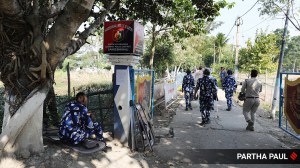- India
- International
UPSC Key-August 2, 2022: Why you should read ‘Macroeconomic Factors’ or ‘Weapons of Mass Destruction’ or ‘Article 44’ for UPSC CSE
Exclusive for Subscribers from Monday to Friday: The Indian Express UPSC Key August 2, 2022 will help you prepare for the Civil Services and other competitive examinations with cues on how to read and understand content from the most authoritative news source in India. Today the topic ranges from Debt to GDP ratio to V shape recession to Stagflation and Recession to Spectrum Allocation to Delhi’s Excise Policy 2021-22 to faceless militancy and many more.
 UPSC Key 2022: Here's what you should be reading from the October 17, 2022 edition of The Indian Express.
UPSC Key 2022: Here's what you should be reading from the October 17, 2022 edition of The Indian Express.Important topics and their relevance in UPSC CSE exam for August 2, 2022. If you missed the August 1, 2022 UPSC key from the Indian Express, read it here
FRONT PAGE
Opp flags inflation, job loss; FM says no recession or stagflation
Syllabus:
Preliminary Examination: Economic and Social Development
Main Examination: General Studies III: Indian Economy and issues relating to planning, mobilization, of resources, growth, development and employment.
Key Points to Ponder:
• What’s the ongoing story- Asserting that India’s economy is showing “very positive signs” and getting “more robust”, Union Finance Minister Nirmala Sitharaman said on Monday that there is “no question” of the country “getting into recession or stagflation”
• What are the key macroeconomic factors in Indian Economy?
• What are the major concerns of macroeconomics in India?
• Macroeconomic and Microeconomic Fundamentals- Compare and Contrast
• What do you understand by ‘Debt to GDP ratio’?
• What is Recession?
• What is the ‘V shape recession’?
• What is Stagflation?
• What comes first stagflation or recession?
• What is worse stagflation or recession?
• Why is Stagflation so unpopular vis a vis recession?
• Know the Types of Inflation like Moderate Inflation, Galloping Inflation, Hyper-Inflation, Stagflation, Deflation, Core Inflation etc.
Other Important Articles Covering the same topic:
📍Fundamentals
📍Inflation vs. Stagflation: What’s the Difference?
📍ExplainSpeaking | How inflation beat the RBI: A recent history
5G auction ends, Govt gets over Rs 1.5 lakh cr
Syllabus:
Preliminary Examination: Current events of national and international importance

Main Examination: General Studies III: Changes in industrial policy and their effects on industrial growth and Science and Technology- developments and their applications and effects in everyday life.
Key Points to Ponder:
• What’s the ongoing story– India’s biggest ever spectrum auction ended Monday, with bids upwards of Rs 1.5 lakh crore coming in after seven days of bidding spread over 40 rounds, belying initial expectations that the auction process would be wrapped up in under three days. Reliance Jio emerged as the largest spender in the 5G spectrum auction, acquiring almost half of all the airwaves sold for more than Rs 88,000 crore, and was also the only one (among four applicants) to have acquired spectrum in the premium 700 MHz band.
• Do you Know-The amount earned spectrum auction is far higher than what the government had anticipated, and the highest compared to the seven auctions since 2010. The highest so far was Rs 1.10 lakh crore in 2015.
• How much spectrum was bought by the applicants?
• What is the reason behind the auction fetching more cash than estimated?
• What is spectrum and how does it work?
• What spectrum do telecom companies require?
• What spectrum will operators bid for?
• What is ‘reserve price’ in spectrum auction
• Why has interest in 700MHz suddenly risen?
• Fifth generation wireless technology (5G)-what do you understand by this?
• Difference between 4G and 5G
• 5G Technology – Key Features
• Spectrum Auction in India-How they are done?
• 5G Spectrum Allocation-who Decides? (Nodal Ministry/Department)
• Telecom Regulatory Authority of India -Role and Mandate
• What are the recommendations made by TRAI with respect to 5G spectrum?
• What concerns has industry raised on TRAI’s 5G spectrum price recommendation?
• What are the other concerns raised by industry bodies over TRAI recommendations?
• Long-term evolution (LTE) mobile broadband networks
• What are Electromagnetic Spectrum and Radio Spectrum? Any correlations between these two terms?
• International Telecommunication Union (ITU)-About, Role and Member Countries
• Department of Telecommunications and Digital Communications Commission- About, Vision, Mission, Functions
• C-Band and 5G communications-what are the apprehensions and challenges associated with 5G Communication
• What is the procedure of Spectrum allocation in India?
Other Important Articles Covering the same topic:
📍Explained: As the 5G spectrum auction concludes, who bought what bands and why?
📍5G coverage to accelerate across Asia Pacific but usage gap remains significant: GSMA
📍5G technology will soon be here. India must prepare
THE CITY
Sobering Monday: Booze shops shut, dry day at bars
Syllabus:
Preliminary Examination: Economic and Social Development-Sustainable Development, Poverty, Inclusion, Demographics, Social Sector Initiatives, etc.
Mains Examination: General Studies II: Functions and responsibilities of the Union and the States, issues and challenges pertaining to the federal structure, devolution of powers and finances up to local levels and challenges therein.
Key Points to Ponder:
• What’s the ongoing story- Several liquor shops and bars in Delhi remained shut on Monday even as the Delhi government allowed them a month-long extension to clear stocks and to make the transition from private shops to government ones smoother.
• Deputy Chief Minister Manish Sisodia announced on July 30, 2022 that the Delhi government’s ambitious new liquor policy i.e. Delhi Excise Policy 2021-22 will be scrapped entirely and that from August 1, only government owned liquor vendors will be allowed to sell alcohol in the national capital- What is Delhi’s Excise Policy 2021-22?
• Why Delhi Police’s Economic Offences Wing (EOW) launched probe into the Delhi government’s new liquor policy?
• What information has the Delhi Police’s Economic Offences Wing (EOW) asked for?
• What did the Chief Secretary’s report say?
Other Important Articles Covering the same topic:
📍Explained: What is the controversy surrounding the Delhi government’s new liquor policy?
GOVT & POLITICS
‘Faceless militancy’ biggest security challenge in J&K: DGP
Syllabus:
Preliminary Examination: Current events of national and international importance.
Mains Examination: General Studies III: Linkages between development and spread of extremism and Role of external state and non-state actors in creating challenges to internal security
Key Points to Ponder:
• What’s the ongoing story- Highlighting a “strategic shift” in Jammu and Kashmir, J&K Police DGP Dilbag Singh said that a “faceless militancy”, in which militants have no past record, is now the biggest security challenge in the Valley.
• What do you understand by the term ‘faceless’ militancy?
• What do you understand by the term ‘Hybrid’ militants?
• As per J&K Police DGP Dilbag Singh, What is the new modus operandi of militants’ handlers in Jammu and Kashmir?
• The lower age of militant recruits is also a major concern according to the J&K Police DGP Dilbag Singh-Highlight the factors why youngsters are attracting more towards militancy in J&K?
• ‘The militancy in Kashmir has entered a “secretive and dangerous” phase’-Elaborate
• “The command structure among militants is missing. There is no reigning force and that makes it dangerous. The separatist leadership is in jail and those who are out have lost their grip. We are fighting an invisible enemy now”-What is the main concern for law enforcement agency?
• What do you understand by ‘Guerrilla warfare’?
• Why is it called guerrilla warfare?
• What is the difference between insurgency and guerrilla warfare?
• What is the difference between militant and insurgent? How militancy is different from insurgency?
• Know these terms-Terrorism, Insurgency, Belligerency and Civil war
Other Important Articles Covering the same topic:
📍New worry in J&K: Officers say militancy entering a ‘secretive, dangerous’ phase
📍Tavleen Singh writes: Another exodus in Kashmir?
IN PARLIAMENT
WMD Bill passed by voice vote in RS; Opp says request for division ignored
Syllabus:
Preliminary Examination: Current events of national and international importance.
Main Examination: General Studies II: Important International institutions, agencies and fora- their structure, mandate.
Key Points to Ponder:
• What’s the ongoing story-The Weapons of Mass Destruction and their Delivery Systems (Prohibition of Unlawful Activities) Amendment Bill, 2022, was passed in Rajya Sabha on Monday. The Bill, introduced by External Affairs Minister S Jaishankar, seeks to ban funding of weapons of mass destruction (WMDs) and gives the Centre the power to freeze, seize or attach financial assets of persons involved in such activities.
• What do you understand by “Weapons of Mass Destruction”?
• What are the types of weapons of mass destruction?
• The Weapons of Mass Destruction and Their Delivery Systems (Prohibition of Unlawful Activities) Act, 2005-Key Highlights
• Weapons of Mass Destruction and their Delivery Systems (Prohibition of Unlawful Activities) Amendment Bill 2022-Aim of the bill?
• Definitions of Nuclear, biological, and chemical (NBC) weapons according to India’s 2005 WMD Act
• Treaty on the Non-Proliferation of Nuclear Weapons (NPT)-Key Provisions
• Comprehensive Nuclear-Test-Ban Treaty (CTBT)-Key Provisions
• The New START Treaty (between the USA and the Russian Federation)
• India and NPT, CTBT-Issues and India’s Apprehension
Other Important Articles Covering the same topic:
📍 Explained: What are WMDs, the existing law on which India now wants to amend?
THE EDITORIAL PAGE
Syllabus:
Preliminary Examination: Indian Polity and Governance-Constitution, Political System, Panchayati Raj, Public Policy, Rights Issues, etc.
Mains Examination:
• General Studies II: Statutory, regulatory and various quasi-judicial bodies.
• General Studies III: Money-laundering and its prevention
Key Points to Ponder:
• What’s the ongoing story- D Sivanandhan writes | ED’s prominence points to a shift: Central agencies have grown more powerful, state and city police are pale shadows of themselves
• According to the author, Today, once high-profile police forces like Mumbai Police and its crime branch, Delhi Police and its special cell, Gujarat Police and its Anti-Terrorism Squad (ATS), Bengaluru Police, Hyderabad Police have become a pale shadow of themselves and central agencies have taken over the investigation of sensational cases-Elaborate this statement
• Why these days the Enforcement Directorate (ED), National Investigation Agency (NIA), Central Bureau of Investigation (CBI), Narcotics Control Bureau (NCB), are in the limelight?
• For your Information-Formed in 1956, the ED became a prime agency following enactment of the Prevention of Money Laundering Act (PMLA) in 2002, implemented from July 1, 2005.
• What was the recent verdict of the Supreme Court (SC), in the Enforcement Directorate’s (ED) sweeping powers under the PMLA.
• In recent years, the National Herald case, the alleged scam in West Bengal school recruitment, and now the Sanjay Raut case have all been handled by the Enforcement Directorate (ED)-Discuss role of the Enforcement Directorate
• Over the past few years, major amendments in key Acts have given teeth to central agencies-Discuss
• According to the author, It is quite clear that the central agencies are now going to be the big brothers of investigations, while state and city police forces function in their shadows with limited powers and jurisdictions-Critically Analyse the statement
• Directorate of Enforcement (ED)-Role and Function
• Enforcement Directorate is a statutory body-True or False?
• Directorate of Enforcement (ED) comes under which Ministry or Organisation?
• The Directorate of Enforcement is a multi-disciplinary organization mandated with investigation of offence of money laundering and violations of foreign exchange laws. The statutory functions of the Directorate includes enforcement
of certain acts-What are those acts?
• What makes Enforcement Directorate so powerful?
• The Prevention of Money Laundering Act, 2002 (PMLA)-Know key highlights
• The Foreign Exchange Management Act, 1999 (FEMA)- Know key highlights
• The Fugitive Economic Offenders Act, 2018 (FEOA)- Know key highlights
Other Important Articles Covering the same topic:
📍ED’s journey from a small enforcement agency to becoming the ‘new CBI’
THE IDEAS PAGE
Syllabus:
Preliminary Examination: Current events of national and international importance.
Mains Examination: General Studies II: India and its neighbourhood- relations.
Key Points to Ponder:
• What’s the ongoing story- As India and Pakistan celebrate the 75th anniversary of their Independence this month and reflect on the tragedies of Partition, it is an appropriate moment to take a fresh look at the unfortunate state of bilateral relations and consider new initiatives to break the stalemate.
• While Delhi has a strong government in place, Islamabad is going through one of the more difficult moments in its history-Elaborate
• India Pakistan Relations-Know the Historical Background
• What makes peace elusive between India-Pakistan in present scenario?
• Current events shaping India-Pakistan Relations-What are they?
• Major ‘changes’ in Indian diplomacy in the last eight years of New Delhi’s towards Pakistan-What is that ‘Change’ which author is trying to highlight?
• How diplomacy worked under former prime minister of India’s like PV Narasimha Rao, H D Deve Gowda, I K Gujral, Atal Bihari Vajpayee, Manmohan Singh and Narendra Modi in the context of Pakistan?
Other Important Articles Covering the same topic:
📍The prospects for Indo-Pak relations in 2022
Syllabus:
Preliminary Examination: Current events of national and international importance.
Mains Examination: General Studies II: India and its neighbourhood- relations
Key Points to Ponder:
• What’s the ongoing story- August 1 marked 18 months of the military coup in Myanmar. According to UN human rights monitors, over 2,000 people have been killed, around 14,000 are in prison, including 90 lawmakers, over 7,00,000 are refugees and half a million internally displaced. Humanitarian aid to coup opponents is blocked. The economy is in free fall.
• Who is Myanmar junta?
• Who is in charge of Myanmar now?
• Is the death penalty common in Myanmar?
• What International organisations is Myanmar part of?
• Know India-Myanmar bilateral relations in detail
• Why is Myanmar important for India?
• Since coup in Myanmar, How India has taken diplomatic approach on Myanmar?
• India and Myanmar and India’s “Neighbourhood First” policy and “Act East” policy-connect the dot
• India and Myanmar bilateral relations-Issues and Challenges
Other Important Articles Covering the same topic:
📍India must prioritise stability in Myanmar
📍Why India must engage with Myanmar
EXPLAINED
Syllabus:
Preliminary Examination: Indian Polity and Governance
Main Examination:
• General Studies II: Indian Constitution—significant provisions etc.
• General Studies II: Government policies and interventions for development in various sectors and issues arising out of their design and implementation.
Key Points to Ponder:
• Article 44 of the Indian Constitution and Uniform Civil Code-What is the ongoing debate?
• What is Article 44 of Indian Constitution i.e. Uniform Civil Code?
• What is Directive principles of State Policy (DPSP)?
• Difference Between Fundamental Rights and Directive principles of State Policy
• ‘Reform of Family Law’ report by Law Commission of India on Article 44-Know in detail
• Issues and Controversy with Uniform Civil Code and Why it has not been Implemented even after seven decades of Independence?
• Know how the government’s stance on a uniform civil code (UCC) has evolved between the year 1991 to 2004?
Other Important Articles Covering the same topic:
📍Govt stand: Personal law review only if ‘sizeable majority’ seek change
📍Uniform civil code vs triple talaq
3 reasons why GST collections are surging
Syllabus:
Preliminary Examination: Economic and Social Development and Indian Polity and Governance
Mains Examination: General Studies II: Functions and responsibilities of the Union and the States, issues and challenges pertaining to the federal structure, devolution of powers and finances up to local levels and challenges therein
Key Points to Ponder:
• What’s the ongoing story- The gross Goods and Services Tax (GST) collections have risen 28 per cent year-on-year to Rs 1,48,995 crore for July (for sales in June), the second highest level since the July 2017 rollout of the indirect tax regime, data released by the Finance Ministry Monday showed. High inflation rate, buoyancy in consumption patterns triggered by the economic recovery, alongside greater enforcement actions against anti-evasion activities have contributed to the rise in GST collections.
• What is the government view on higher GST revenues?
• What do the improved revenues signify?
• What is the detailed break-up of recent GST revenues?
• What are the different types of Goods and Services Tax (GST)?
• Know the differences between Central GST (CGST), State GST (SGST), Union territory GST (UTGST) and Integrated GST (IGST)
• How would a particular transaction of goods and services be taxed simultaneously under Central GST (CGST) and State GST (SGST)?
• What are the benefits of Goods and Services Tax (GST) in India?
• Goods and Services Tax (GST)-Issues and Challenges
• GST Council and Article 279A of the Constitution-Key Provisions
• GST Council and Members-Know in detail
• What is the role of GST Council?
• Several countries moved to the GST regime long before India did in 2017. But, the mechanism of the GST Council itself is unique to India-What is unique in India’s GST?
• What Supreme Court of India said on Federalism in India in Union of India and Anr versus M/s Mohit Minerals Through Director case?
Other Important Articles Covering the same topic:
📍Explained: The SC ruling that GST Council decisions are not binding on Centre or states
📍12 Different Types of Federalism (with Examples and Pros & Cons)
📍The Paradox of ‘Centralised Federalism’: An Analysis of the Challenges to India’s Federal Design
For any queries and feedback, contact priya.shukla@indianexpress.com
The UPSC KEY Indian Express is now on Telegram. Click here to join our channel and stay updated with the latest Updates.
Apr 25: Latest News
- 01
- 02
- 03
- 04
- 05







































